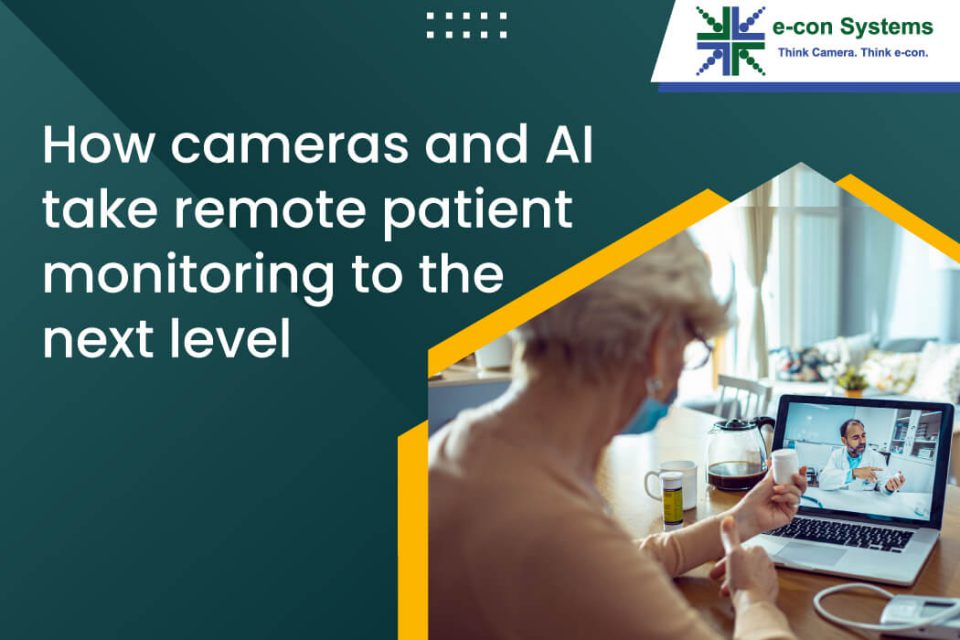Whether we like it or not, the adoption of artificial intelligence is on the rise in every sector. Though AI can’t compete with the human brain in terms of cognitive abilities yet, it has already started replacing us in performing mundane as well as intelligent tasks. And the medical field is not an exception to this.
It has been fascinating to observe how new applications and use cases have emerged where AI works in harmony with other technologies to elevate human experiences. Remote patient monitoring is one such application where artificial intelligence leverages image and video data captured using camera modules to automate various tasks.
So let us look at how these two technologies have helped improve the experience for patients and caregivers. Toward the end, we will also learn what the future looks like for remote patient monitoring when it comes to the use of AI and cameras.
The old vs the AI-enabled way of doing remote patient monitoring
Remote Patient Monitoring (RPM) is not new to us. It has been around for a while. But the pandemic has accelerated (or rather forced) the implementation of the system in healthcare facilities. However, traditional RPM was all about having a camera stream the video over a network to a display in a different location for manual monitoring. Though it helped monitor patients without being in the same room, this required staff to be available for viewing the display 24×7. These systems also lacked the ability to utilize the data captured to do any kind of analysis.
This is where AI makes a sea of difference. The application of AI in remote patient monitoring made it possible to automate it while collecting data to be fed into various types of predictive ML (machine learning) based models for inferencing.
The role of AI and cameras in enhancing the effectiveness of remote patient monitoring devices
For AI to be applied effectively to remote patient monitoring, embedded vision and camera technology also had to evolve. From high-resolution cameras to NIR cameras and RGB-IR cameras, new-age embedded cameras have enabled capturing high-quality images irrespective of the lighting conditions in the patient’s room.
Remote patient monitoring is dependent on one or more digital imaging solutions that are integrated into hospital networks. It allows health workers to monitor multiple patients, and clinical teams to assess patient conditions from a remote location.
By leveraging artificial intelligence, remote patient monitoring is moving from mere video monitoring to doing behavioral analyses like fall detection, tracking patient movements, monitoring people in a room, and many such. The patient’s behavior is then classified and analyzed using frameworks like PeopleNet to prevent falls from happening.
Let us try to understand this through an example.
Imagine a patient on a highly sedative medication trying to wake up from a hospital bed. An AI model trained to identify patients who are moving from a minimally conscious state can send an alert to a caretaker or nurse for immediate attention. This is made possible by continuously capturing the video of the patient using the camera in the RPM device, thereby feeding the required image and video data to the AI model.
And completely automating this process using cameras and AI offers the following advantages:
- Eliminates the need for 24×7 manual monitoring.
- Avoids the possibility of human negligence or error while monitoring, especially in cases of a patient fall.
The camera selection process is very important when it comes to designing an AI-based remote patient monitoring system. It is always recommended to take the help of an imaging expert like e-con Systems to guide you through the camera evaluation, selection, and integration stages. To learn more about how cameras make a difference to RPM, please have a look at the article How cutting-edge cameras elevate Remote Patient Monitoring (RPM) to new heights.
Cameras and AI in remote patient monitoring – what the future looks like
Though remote patient monitoring has been a great innovation in medical care, it raises questions with respect to patient privacy. This is because, video data of patients have to be streamed over a network and stored in some form for any type of analysis to be done. Given that this data is very sensitive and there isn’t much control over how it will be used, not all patients are comfortable with this way of monitoring.
This is likely to give rise to the adoption of 3D depth mapping technologies in remote patient monitoring. Using 3D depth cameras like time of flight or stereo cameras, patient movement can be monitored by collecting the depth data alone instead of the color data or the real video. The AI algorithm can also be trained to be able to detect falls by using depth data. This enhances the privacy of patients and gives them peace of mind.
Interestingly, e-con Systems is already equipped for this change by offering 3D depth cameras including:
In addition to developments in camera technology, AI algorithms are also becoming more mature and sophisticated. This will lead to more and more product developers coming up with innovative use cases in remote patient monitoring.
With cameras and AI algorithms getting better and better, changes are happening in patient monitoring at lightning speed. And e-con Systems is excited to be a part of this journey by developing specialized camera solutions for RPM devices. We have already worked with multiple remote patient monitoring device manufacturers to smoothly integrate our cameras into their systems. The fact that our cameras come with a 3-year warranty helps our customers ensure a longer life for their products.
As always, if you are looking for help in integrating cameras into your product, please write to us at camerasolutions@e-consystems.com. You could visit the Camera Selector to have a look at e-con’s complete portfolio of cameras.

Balaji is a camera expert with 18+ years of experience in embedded product design, camera solutions, and product development. In e-con Systems, he has built numerous camera solutions in the field of ophthalmology, laboratory equipment, dentistry, assistive technology, dermatology, and more. He has played an integral part in helping many customers build their products by integrating the right vision technology into them.




